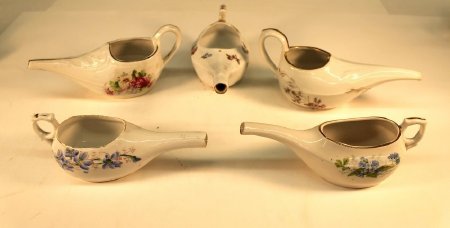Object ID Number:
EH102149
Object Name:
Invalid Feeder
Type:
Pap Boat
Description / History:
Set of five white porcelain pap boats with gold trim and curved spouts. Pap boats are a type of invalid feeder generally used to feed the invalid or child pap: a mixture of soaked bread with meal and sugar, sometimes chewed by a nurse to get the right smooth consistancy.
Each also has a floral decoration via the process of transfer printing. Transfer printing was developed in England in the mid–18th century and involves printing a pattern on a tissue via a copper plate and then transfering it onto the ceramic object.
A) Production Date: 1870–1880
White porcelain pap boat with gold trim. Blue, green and red floral design printed on both sides.
B) Production Date: 1870–1930
Country: Germany
White porcelain pap boat with gold trim. Engraved leaf design on whole spout. Intricate pink and yellow rose design on both sides. Green circular stamp on the bottom that reads, "GERMANY".
C) Production Date: 1875–1930
White porcelain pap boat with gold trim that is mostly rubbed off. An indent at the end of the spout suggesting this may have been used for a young child. Red, blue and yellow printed flowers are surrounding the rim of the feeder.
D) Production Date: 1882–1891
Country: France
White porcelain pap boat with gold trim and a leaf design engraved into the curved spout. Printed grey and pink flowers surround the feeder starting under the spout. Bottom is engraved with "C...H" with a letter in the middle too aged to interpret. Has a grey circular stamp that reads, "CH.FIELD HAVILAND. LIGOMES". Also has a green stamp that reads "CFH/GDM".
David Haviland, having owned a china shop in New York City, decided to move his production to Limoges, France due to the violence of the American Civil War. The Haviland Company became very popular world–wide and, after the war, their products became famous in the U.S.. Years later, his nephew, Charles Field Haviland, eventually married into another porcelain family and took over their production in 1868. The green stamp comes from after he retired by the end of 1881, when the firm of E. Gerard Dufraisseix et Morel took over its operations. This new firm was allowed to use Charles' initials in conjunction with G.D.M, as well as the C.H.F. Haviland decorator's mark.
E) Production Date: 1870–1930
Country: Germany
White porcelain pap boat with gold trim. A blue flower design is printed on either side of the feeder. The bottom is engraved with the number 100 and is stamped with a circular redish brown stamp that reads, "MADE IN GERMANY".
Each also has a floral decoration via the process of transfer printing. Transfer printing was developed in England in the mid–18th century and involves printing a pattern on a tissue via a copper plate and then transfering it onto the ceramic object.
A) Production Date: 1870–1880
White porcelain pap boat with gold trim. Blue, green and red floral design printed on both sides.
B) Production Date: 1870–1930
Country: Germany
White porcelain pap boat with gold trim. Engraved leaf design on whole spout. Intricate pink and yellow rose design on both sides. Green circular stamp on the bottom that reads, "GERMANY".
C) Production Date: 1875–1930
White porcelain pap boat with gold trim that is mostly rubbed off. An indent at the end of the spout suggesting this may have been used for a young child. Red, blue and yellow printed flowers are surrounding the rim of the feeder.
D) Production Date: 1882–1891
Country: France
White porcelain pap boat with gold trim and a leaf design engraved into the curved spout. Printed grey and pink flowers surround the feeder starting under the spout. Bottom is engraved with "C...H" with a letter in the middle too aged to interpret. Has a grey circular stamp that reads, "CH.FIELD HAVILAND. LIGOMES". Also has a green stamp that reads "CFH/GDM".
David Haviland, having owned a china shop in New York City, decided to move his production to Limoges, France due to the violence of the American Civil War. The Haviland Company became very popular world–wide and, after the war, their products became famous in the U.S.. Years later, his nephew, Charles Field Haviland, eventually married into another porcelain family and took over their production in 1868. The green stamp comes from after he retired by the end of 1881, when the firm of E. Gerard Dufraisseix et Morel took over its operations. This new firm was allowed to use Charles' initials in conjunction with G.D.M, as well as the C.H.F. Haviland decorator's mark.
E) Production Date: 1870–1930
Country: Germany
White porcelain pap boat with gold trim. A blue flower design is printed on either side of the feeder. The bottom is engraved with the number 100 and is stamped with a circular redish brown stamp that reads, "MADE IN GERMANY".
3D Image Information:
The 3 dimensional image can be viewed using Google Chrome, Safari, or Firefox browsers.
3 Dimentional Image:
